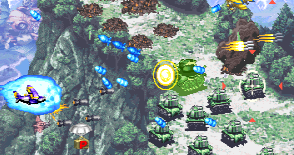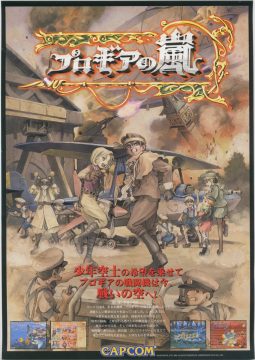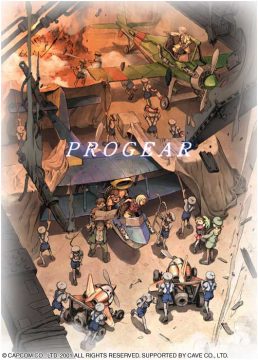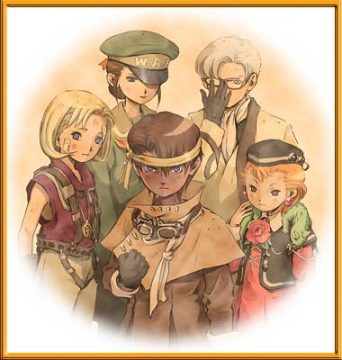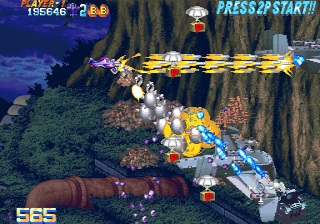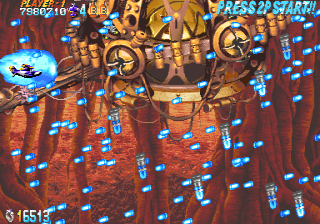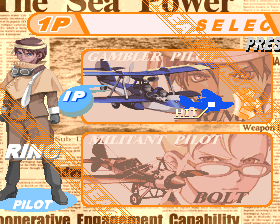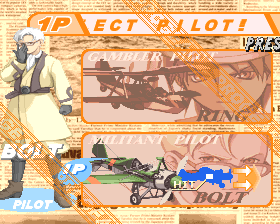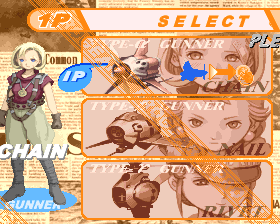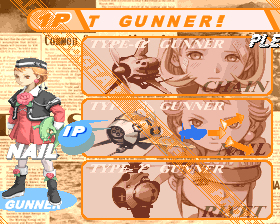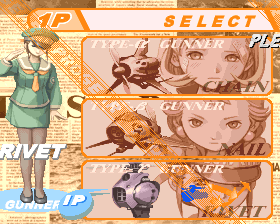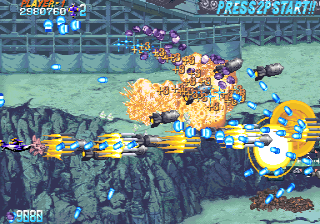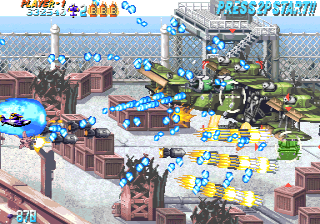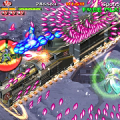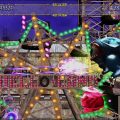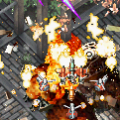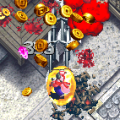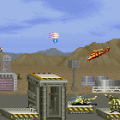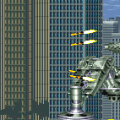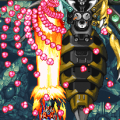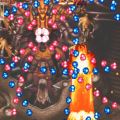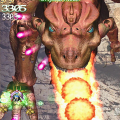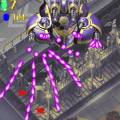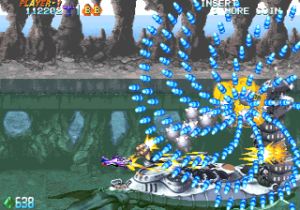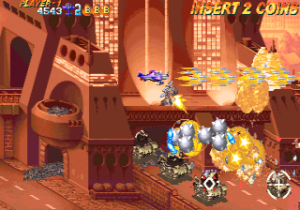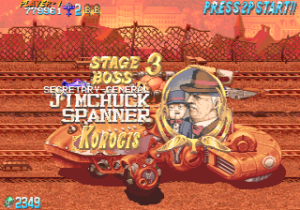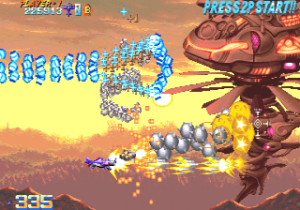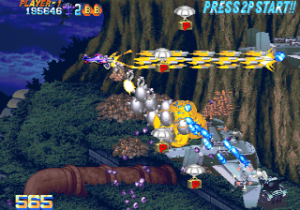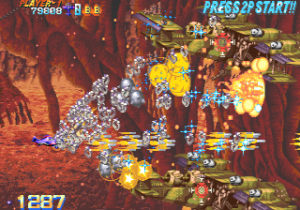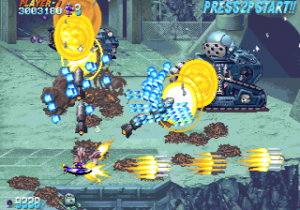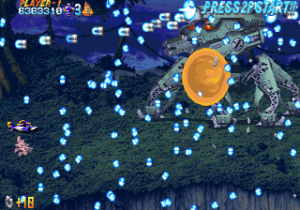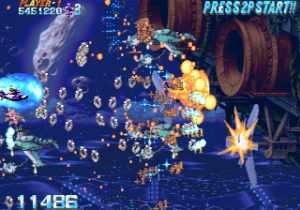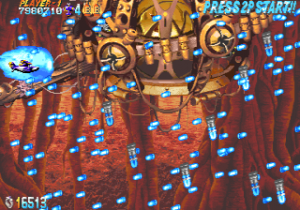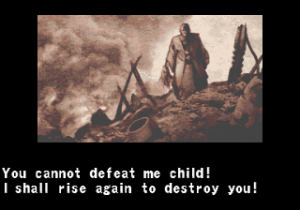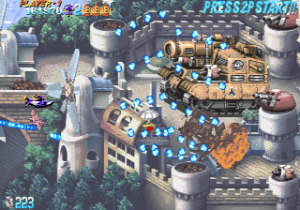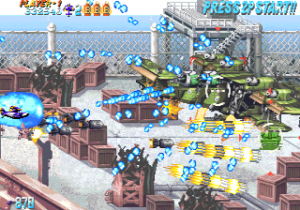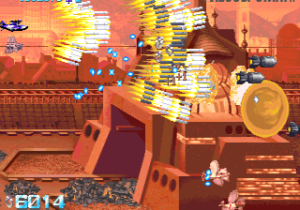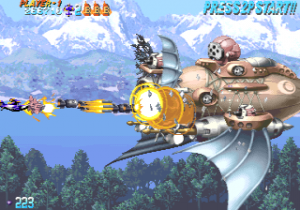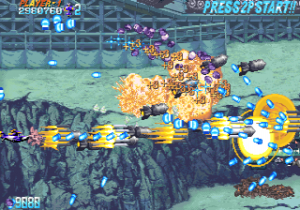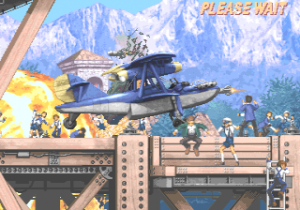In Game One’s excellent mini-documentary on arcade shooters “Japon: Histoire du Shooting Game“, Tsuneki Ikeda of Cave sheds a little light on why it took Cave six years to approach a horizontally oriented shoot-em-up. To paraphrase: “In vertical scrolling, everything is obvious… you can see straight away if you are going to get hit or not, but in horizontal scrolling, it’s impossible to see properly if you are in the path of a bullet.” Playing a vertically oriented shooter in the arcade, particularly on one of the Japanese style “candy cab” sit-down cabinets, it’s easy to see what he’s talking about: bullets appear to get closer as they scroll down the screen, nearer to the player. It was unclear, then, just how well Cave’s style of covering the screen in bullets would work in a horizontally oriented game; how can you keep those trademark patterns challenging and tight, when even the most trained eye only perceives them moving across a horizon? Nevertheless, there was enough interest within Cave to give it a try. The result was Progear in 2001, licensed out to Capcom for its CPS2 arcade hardware. While many within the company don’t consider the game a success, it’s still a favorite among shooter fans for its excellent presentation and fun gameplay.
What makes Progear stand out to this day, first and foremost, is the beautiful steampunk style. The background of Victorian-style news clippings with wartime headlines, along with the scattering of biplane and zeppelin enemies, pull you into the game’s anachronistic setting. There are also several elegant looking locomotives, and trains always make good shoot-em-ups even better. Hot B’s Genesis/Megadrive shooter Steel Empire adapted the steampunk style 9 years earlier, but Progear carves out its own unique look, along with some inspiration from anime such as Miyazaki’s “Castle in the Sky“. Cave’s Junya “Joker Jun” Inoue provided the game with its fabulously stylized look and character designs. There are some similarities to his drawing work on games like Batsugun and ESP Ra. De., but there is just something about this game in particular that makes the characters seem to jump out of the screen. Each of the five lead children have an inexperienced yet determined look about them that will charm players as they select their ship style, while the portraits of the evil boss elders will intimidate players with their baleful scowls. As the game starts, with the Engrish taunt “Are you ready set? We started on a trip to hell,” the view cuts to your player’s ship in a hangar that is burning down fast. You are shown steering past bystanders on the runway, taking off just as it breaks. Once in the sky you can see in the background your town in ruins below, with the first boss’s mighty airship looming above. Now THIS is how you begin a shooting game!
You have a choice of two male pilots and three female gunners, each named after metalworking objects.
Pilots
Type B: Bolt (“Militant”)
A straight-forward shot with a faster ship than Ring.
Gunners
Type Alpha: Chain
A straight-shot missile barrage. Good all-around gunner that deals a decent amount of damage.
Type Beta: Nail
SHOT: Spread-shot cannon balls. They deal the most damage of any gunner’s shot, but they are just a tiny bit slow.
By default, your gunner options stay below the pilot. However, you can change their formation by hitting shot and bomb together when you select to get one on top and bottom, or 2P start along with 1P shot and bomb to put them both in front of the ship. Casual players won’t be able to tell the difference much, but it’s fun to experiment. Additionally, by holding the 1P start button when you make a selection, you can choose an alternate costume for each character.
Like several other Cave shoot-em-ups, you will want to alternate between tapping and holding down the shot button to properly ward off enemies. Tapping the shot button fires your pilot’s main shot, while holding down the shot button fires your gunner’s shot. Holding down shot also slows down your ship, but this isn’t necessarily a bad thing since you want that extra precision once in a while when dodging some of those really thick bullet patterns. Balancing your two types of shot also plays heavily into the scoring system. When destroying an enemy, bullets fired by that enemy and ones in close proximity are “cancelled” and turned into point items. Your pilot’s shot makes rings, while the gunner’s shot makes jewels. You can only get high value jewels by having a high ring count, and as you collect those bigger jewels, the ring counter will drop down. It’s a cycle of collecting rings, cashing them in for the bigger jewels with the lock shot, then building your ring count back up again. Changing between the different types of fire also has the effect of sucking all of the point items into your ship, which is both helpful AND incredibly satisfying.
This scoring system can be really overwhelming at first, but practice makes perfect. It helps to check the lower left meter to see how many rings you have and to look out for when the icon changes, signalling you to cash in. The genius of all this shot management is that you’re never in a constant state of button mashing, nor are you just holding the button down like a monkey. It’s always back and forth between both shots and both ship speeds, which makes for a lot more dynamic experience. At the end of each stage you are judged by how “active” your gunner is, how “safe” your fighter was (how many lives you lost) and err… how “lovely” your performance was (this is actually just an average based on the “active” and “safe” values.)
The stage and boss design is well above par. The enemy forces attack you on all fronts: biplanes fill the air while giant tanks target you from the ground, even a few battleships in the shipyard of stage 2. The backdrops are always very colorful, but the contrast is balanced enough that the bullets stick out like they should (save maybe for a few problem areas later in the game.) The rather short first level has you taking out some push-over enemies on the hillside as you get used to piloting your ship. The following boss fight with Ballossum Pench’s winged zeppelin can teach you a lot about the rest of the game as well as some good shoot-em-up tactics in general. You want to guide his fire for the aimed shots while steering clear of his static bullet patterns. This means you should get a good spot somewhere you’re not trapped next to the sides of the screen and then be on the move constantly so you’re always one step ahead of him. This is especially important once he starts shooting the large streams of fire that slowly accelerate towards your last position. These crazy accelerating gobs and streams of bright blue bullets may defy physics, but it all works out very well for the kind of intense dodging you’d expect from a Cave game. They stop, speed up, expand, and sometimes they even fall like bricks. Cave would later adapt these dynamic bullet paths in games like Ketsui, but give or take a few isolated examples, it started with this game.
By the end of your fight with the Stage 2 boss, Gabriel Hammer’s finned submarine battleship, you will have run the gamut of insane bullet patterns. It shoots out pods that drop floating bullets that eventually collapse right on top of you. Turrets stream scattered fire all over the screen. Eventually the mechanized beast shoots up its neck and starts letting out some much faster fire… take it out as quickly as you can, because he has one last attack in store. Watch as he fills the screen with bullets, VERY literally. So many bullets, in fact, that the game slows to an almost screeching halt. Actually this isn’t too hard to avoid, as long as you keep your hitbox clear of the really slow moving but dense bullets (use the cockpit as an easy reference point for your weak spot.) It’s more intimidating than anything. Also, if you haven’t been paying attention, this is the PERFECT time to cash in on those jewels. As you move onward into the dusk horizon of Stage 3, bear in mind all you’ve learned. It’s a good goal for an amateur pilot to make it past Stage 3’s boss on a single credit. Jimchuck Spanner and his ventriloquist dummy won’t let you off so easy, however. By this point in the game, the firepower doesn’t let up, so you’ll need to be dodging as quickly as you can.
The last two stages in the game are where things get really hairy… if the first half of the game is still giving you any grief, you’ll probably want to turn back. Both of these stages, while still keeping the horizontal screen ratio, scroll UPWARDS instead of to the right. Stage 4 has you scaling a giant floating mountain range that the enemy has outfitted with tons of turrets, on-rails armored vehicles, and just about every flight attack formation from the last few parts of the game, all going on in succession of each other… often times simultaneously. If the game starts to feel a little uninspired at some point, it would be here. The game stays the course with the challenge, sure, but it’s just enemy after enemy as you slowly ascend to the sky. At this point in the game you can’t just get far away and play it safe, you’re forced to squeeze your way through the bullets as the formations glob on top of each other.
If you’re new to Cave or arcade style shooting games in general, Progear is one of the best places to start. Sucking up giant diamonds just looks and feels great, and you’ll have something to be proud of if you can net a decent score. If you’re a seasoned bullet hell veteran, also take note that this game does have a second loop and a “true last boss” for expert players. You’re not going to see this boss if you credit feed or play recklessly.
What’s an arcade shooter without some adrenaline-stirring background music? To be honest, Progear‘s music is easily the most lackluster thing about the game. Really quite a shame, considering how spot-on the art design is. Calling it terrible would be taking it a bit too far, but it would be a stretch to call a single one of these tunes memorable. The music in the intro to the game does a fair to middling job of raising your spirits, but none of the other BGM comes close. Stage 2 and on, the stage music is just too simple and repetitive, to the point that it’s plodding. The boss theme, which is shared by each boss, changes the mood and works at the most basic level, but still isn’t worth listening to outside of the game. The remix of the Stage 1 music that plays during the name entry screen, stylized to sound like a wind-up jewelry box being opened, does stand out as a charmer, but that doesn’t contribute much overall. Now, there’s something to be said about shmup music that’s un-invasive. Mars Matrix, for example, is scored with head-nodding techno beats that don’t jump out at you too much. This works well since Mars Matrix requires your undivided attention at all times. A better comparison would be the music in Raiden Fighters Jet. Not so much the 200+ BPM tempo, but those endlessly looping soulless riffs have a lot in common with Progear‘s offerings. Once again the shoe fits, though; the gameplay in Raiden Fighters Jet is dizzying enough that the chaotic MIDI-Gabber sounds give it that little push that sends your sanity right over the edge. Progear‘s music simply has no excuse to be as mediocre as it is. Also note that if you’re playing the US version of the game, all the character voices were just ripped out instead of being translated and re-recorded.
If Progear comes across as having a few faults, you can chalk it up to a pretty taxing development process. It ended up being a solid game that pushed the limits of its hardware, but it wasn’t without a lot of trial and error. There was enough of a challenge in setting out to make a horizontally oriented “bullet hell” game. Their business deal with Capcom limited the development cycle to only six months, just to have the release postponed for a whole year when it was finally finished. The small team had to learn to work with Capcom’s CPS2 arcade hardware for the first time, which was practically like learning to program all over again for them. Keep in mind the CPS2 hardware was eight years old when Progear was finally released and the CPS3 hardware had been out for roughly half that time. “Uh… it was a learning experience,” Junya Inoue commented on adjusting to the hardware. “Well, there’s only 16 colors [per tile], and when moving a lot of sprites there’s a lot of slowdown. Also, the pixels are non-square (height longer than width), so when you include a normal character drawing it grows vertically. So, supposing your character is going to be stretched you first have to make revisions. The fact that it wasn’t just “drawing pictures” was work. It was the first time I had done something like that.” The problems didn’t end with sprite-pushing… even the backgrounds took a lot of work to nail. “During development, we couldn’t get the backgrounds to work at all and even some that looked like they were black and white,” Inoue added. “The programmers were saying, “make me some pretty backgrounds like Capcom” but it just couldn’t be done. I thought, “Strange. Is this the same hardware?””
The learning experience Cave had with Progear later helped them in the making of their most successful shooter yet, Deathsmiles. The true spiritual successor to Progear, however, is Akai Katana. There isn’t anything storywise tying the two together, but the beautiful 2D art and military theme builds on the look of Progear while making it a bit darker and more mature. It’s obvious that Progear was the jumping off point for Akai Katana, but almost everything about the game is pushed much closer to the edge, into Cave veteran territory. The bullets get so numerous that the player now has the ability to push them all away momentarily. The game brings over some trademarks from the Dodonpachi series also, like the focused laser attack and combo hit counter. Progear almost seems plain in comparison, but it’s still one of the easiest Cave shooters to recommend to someone unfamiliar with their library. It’s a shame that the Capcom connection will keep it from ever being re-released, barring some strange miracle. Progear still deserves praise today, for setting the standards it did and paving the way for what a modern arcade shoot-em-up could be, not to mention being the perfect gateway drug for the distinct brand of mania only Cave can provide.
